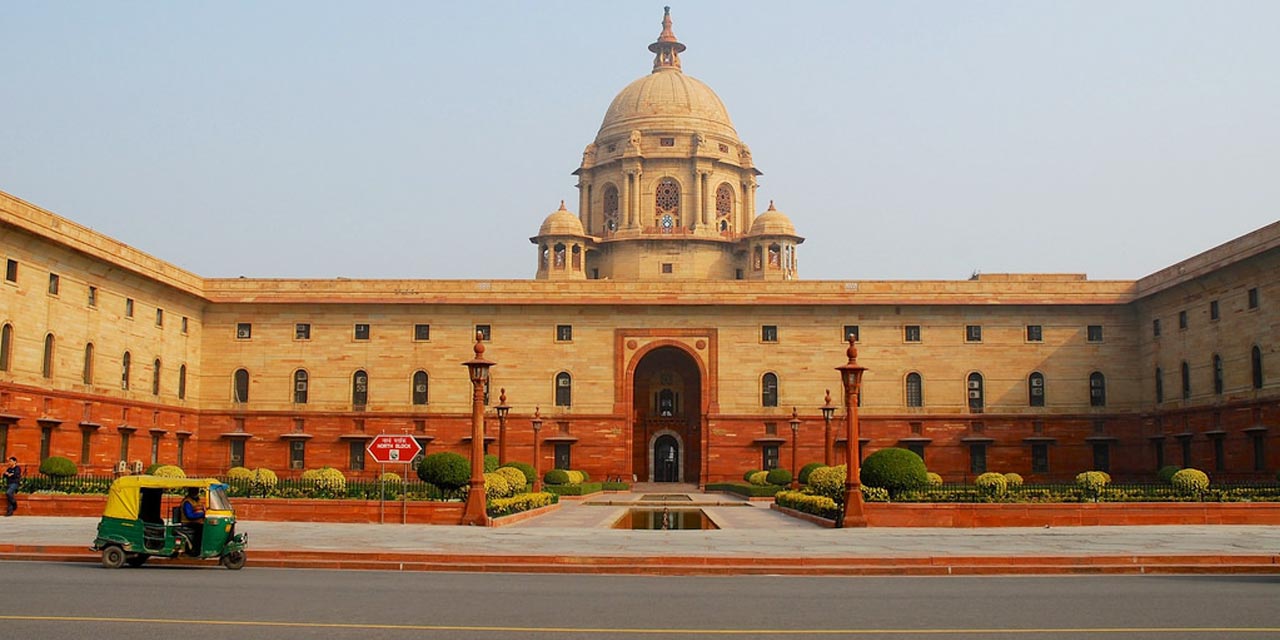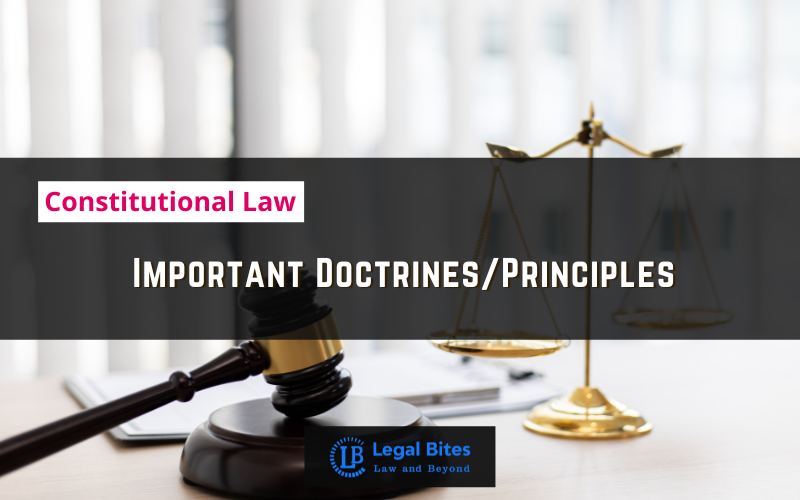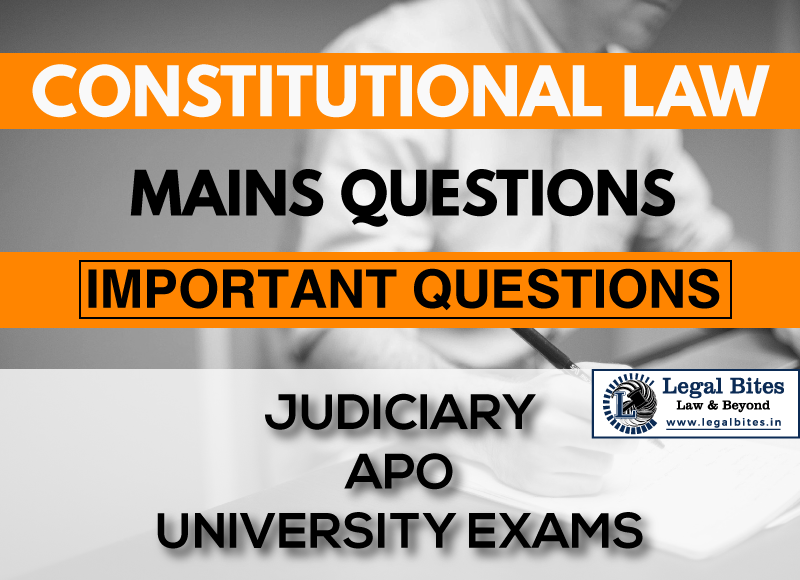National Emergency Provisions Under the Indian Constitution
National Emergency as stated under the Constitution of India is employed in our country by the President. This special machinery of the central government is exercised in order to control and curb certain aggressive and untoward circumstances that might lead to a turmoil or disorder in the country. Introduction The term ‘emergency’ as characterized under Oxford Dictionary signifies… Read More »
;
National Emergency as stated under the Constitution of India is employed in our country by the President. This special machinery of the central government is exercised in order to control and curb certain aggressive and untoward circumstances that might lead to a turmoil or disorder in the country. Introduction The term ‘emergency’ as characterized under Oxford Dictionary signifies “a genuine, unforeseen, and frequently dangerous circumstance requiring prompt action“. One...
National Emergency as stated under the Constitution of India is employed in our country by the President. This special machinery of the central government is exercised in order to control and curb certain aggressive and untoward circumstances that might lead to a turmoil or disorder in the country.
Introduction
The term ‘emergency’ as characterized under Oxford Dictionary signifies “a genuine, unforeseen, and frequently dangerous circumstance requiring prompt action“. One can rightly say a democracy which is reduced in having a state of emergency as its unique paradigm, is no longer a democracy. Indian Federation is one of a kind in the world wherein case of an emergency; it can change itself into a totally unitary framework.
Article 352- Proclamation of Emergency
Article 352(Part 18) of the Indian Constitution makes reference to National Emergency which is enforced when there is a grave risk to the security of India or any of its regions because of war, armed rebellion and external aggression. Such emergency will be enforced by the President based on composed solicitation by the Council of Ministers headed by the Prime Minister.
Article 352 states that:
If the President is satisfied that a grave emergency exists whereby the security of India or of any part of the territory thereof is threatened, whether by war or external aggression or armed rebellion[1], he may, by Proclamation, make a declaration to that effect in respect of the whole of India or of such part of the territory thereof as may be specified in the Proclamation[2].
A. Procedure for Proclamation of Emergency
Before the actual outbreak of war or any other invasion or uprising, a Declaration of Emergency can be made, if the President is convinced that it is an imminent danger. An Authorization issued by a subsequent Proclamation can always modify or withdraw the previously approved proclamation.
Every national emergency declaration is required to be put before each House of Parliament and will cease to exist after one month from the date of its issue unless it is ratified by the Parliament and the emergency can continue for 6 months unless the President revokes it.
The Executive, Legislative and Administrative Powers rest with the Union during Emergency though the State Council isn’t suspended. Article 250[3] of the Constitution grants the power to the Union Government to administer on all subjects identified in the State List.
B. Grounds
There are three grounds on which a Proclamation of Emergency can be issued:
-
War
War means a hostile contention by means of armed forces, carried on between nations, states, or rulers, or between parties in the same nation or state.[4] After the 42nd Amendment Act, duration of President’s rule in a state was extended from 6 months to 1 year, thus, facilitating the proclamation of national emergency in any part of the territory of India.
-
External aggression
It includes one-state unilateral aggression against another State of force without a formal declaration of war. As long as the other State refuses to react with equal aggressive actions, external aggression may be considered.
-
Armed rebellion
A deliberate and organized resistance, by use of force and arms against the laws or operations of the government as committed by a subject.[5] The word ‘armed rebellion’ replaced ‘internal disturbance’ under article 352 after the 44th Amendment to the Constitution. This amendment also made it mandatory for the President to enforce a proclamation only on the written order from the cabinet.
When a national emergency is declared on the grounds of ‘war’ or ‘external aggression’, it is known as ‘External Emergency’ and when it is declared on the ground of ‘armed rebellion’, it is known as ‘Internal Emergency’.
C. Suspension of Fundamental Rights
According to Article 358, all the six rights under Article 19 are automatically suspended on the Proclamation of Emergency. No separate notification is required in order to prove their adjournment. The 44th Amendment Act of 1978, restricted the authority of this provision in recollecting that the rights under Article 19 can only be suspended when the emergency is declared on grounds of war or external aggression and not on the declaration on the basis of armed rebellion.
The second modification included that, only the rights related to the emergency are protected from being challenged while executive action taken only on those specific rights are immune to any challenges, during the course of an emergency.
Under Article 359,[6] the President may suspend the privilege to move to the Courts for authorization of Fundamental Rights, on approval from the State[7], during emergency except Article 20 and 21 which are still enforceable. This implies that the most basic rights of a human being are at stake in cases of emergency, making it a highly debatable issue. This was again added by the 44th Constitutional Amendment Act of 1978.
Fundamental Rights in its simplest sense can never be abrogated, and any mere invasion on these rights amounts to a breach of them. It is also the primary duty of the government to safeguard the Fundamental Rights of each and every individual, and the right of an individual to approach the court if there is a breach of any of these rights. But when such rights are taken away and there is no recourse left to safeguard them, such instances depict stories of grave injustice and therefore, it becomes a serious matter of concern.
Effects on Centre-State relations
- Executive power rests totally in the hands of the central government. It can give executive directions to the state on ‘any’ matter.
- The Legislative authority empowers the centre to make laws on subjects mentioned in the State List. The decentralisation of power is particularly, suspended.
- The Financial functions include the reduction or cancellation of transfers from the centre to states. Such reservations continue till the end of the financial year in which the emergency ceases to operate.
Lok Sabha and the State Assembly
The usual life of the Lok Sabha which is 5 years, can be extended beyond its normal term for a period of one year at a time. However, this extension cannot continue beyond six months after the emergency has ceased to operate. In a similar parallel, the tenure of the State Legislative Assembly can be extended for a period of one year, but not beyond six months after the emergency has ceased to operate.
Amendments that laid the genesis of reason
1. 42nd Constitutional Amendment Act, 1976
- The proclamation of National Emergency may be applicable to the entire country or apart of it. It enabled the President of India to limit the operation of this provision to a specified part of the country.
- The Executive and Legislative functions, as mentioned to be under operation during an emergency, extends not only to the state where such an emergency is in operation but also to any other state.
2. 44th Constitutional Amendment Act, 1978
- ‘Internal disturbance’, being too vague a connotation was replaced by ‘Armed rebellion’.
- The 38th Amendment Act of 1975 made the declaration of national emergency immune from Judicial Review. This was struck down by the 44th CA, 1978. Further, in the Minerva Mills case(1980), it was held that the proclamation could be challenged on the ground of malafide or if it is based on extraneous or irrelevant facts.
- The proclamation must be approved by both the houses within one month from the date of its issue. Originally, the duration would be for two months.
- The President cannot declare an emergency until there is written recommendation from the cabinet. This not only includes the Prime Minister but also other ministers of cabinet rank and their prior approval.
- Periodical parliamentary approval after every six months was made mandatory for the continuation of this provision.
- The concept of Special Majority for the proclamation or continuance of such a provision by either House of Parliament was added to put an end to power politics.
- The President must revoke a proclamation if the Lok Sabha passes a resolution disapproving its continuation, by a simple majority.
- The resolution for disapproval of Proclamation is required to be passed by the Lok Sabha only while the approval needs to be passed by both Houses of Parliament. The former needs a simple majority while the latter, a special majority.
- If 1/10th of the total number of members of the Lok Sabha gove a written notice to the Speaker or the President, a special sitting must be held within 14 days, to decide upon the discontinuation of such a provision.
- The scope of Articles 358 and 359 was reduced significantly and has been mentioned in the previous sections.
National Emergency of 1975: Revisited
National Emergency has been enforced thrice in the nation; namely in 1962 at time of Chinese Aggression, in 1971 amidst the Indo-Pak war and in 1975 on the grounds of unsettling Internal Disturbances. The most talked-about is the 1975 Emergency.
The then President Fakhruddin Ali Ahmed, on the advice of Prime Minister Indira Gandhi, declared an emergency on 25th June 1975 for a period of 21 long months. This was a taciturn move in the political and economic affairs of India as the powers were bestowed in the then Prime Minister and even elections were suspended.
The ground for an emergency was cited as ‘internal disturbance’ after which in the 44th Amendment to the Constitution, this termed has been replaced by Armed Rebellion. The supreme law of the land, the Constitution and the world’s largest democracy were at standstill with no gleaming ray of hope.
In the words of the Supreme Court, “civil liberties were withdrawn to a great extent; important fundamental rights of the people were suspended; strict censorship on the press was placed, and judicial powers were crippled to a large extent.”[8]
We have seen infringement of Fundamental Rights whenever an emergency is enforced and this is high time that such political activities must be investigated shrewdly in the world’s largest democracy.
[1] Substituted by the Constitution (Forty-fourth Amendment) Act, 1978 for “internal disturbance” (w.e.f. 20-6-1979).
[2] Inserted by the Constitution (Forty-second Amendment) Act, 1976 (w.e.f. 3-1-1977).
[3] Power of Parliament to legislate with respect to any matter in the State List if a Proclamation of Emergency is in operation.
[4] As defined in Black’s Law Dictionary.
[5] As defined in Black’s Law Dictionary.
[6] Suspension of the enforcement of the rights conferred by Part III during emergencies.
[7] The term ‘State’ is used herein the same sense as it was used in Article 12. It means that the power to suspend is entrusted not only to Parliament but also to the executive of the Union and even to subordinate authority.
[8] In Re the Special Courts Bill, 1978; (1979) 1 SCC 380.




